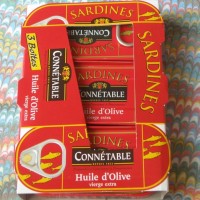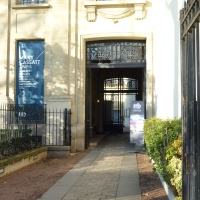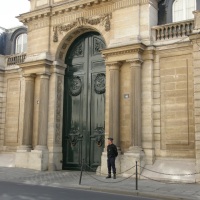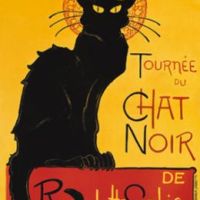To the memory of Raymond Hummel, 1886–1916, and John Sieber, 1893–1917, and to the 166 men and 1 woman of Perth Academy who died in the Great War.
The remains of my great-uncle Raymond Hummel lie in France, in a cemetery called Sucrerie. He died on 19 May 1916 at Colincamps, a village roughly mid-way between Amiens and Arras. He had arrived in France as Second Lieutenant in the West Yorkshire regiment (known as the Prince of Wales’s Own) about a week earlier. His death did not occur during one of the epic battles (Passchendaele, Vimy Ridge), but during a relatively “quiet” period several weeks before the Somme offensive, when the trench he occupied was shelled. He was 29 years old.
I know very little about him. He was one of twins, in a family of six brothers and one sister (I am descended from the sister). His father was a chemistry professor at the University of Leeds, and the family lived in a row house near the university. You can see it on Google Street View, and to modern eyes it looks wholly inadequate for a family of nine.
Raymond wasn’t married. He signed up in August 1914 as a private, but was promoted to officer after a few weeks. I don’t know what he did between August 1914 and May 1916. His widowed mother received the news of his death in a telegram about four days after it happened. She wrote to the Secretary of the War Office asking for details, and he promised to pass the request to the regimental officer in charge, but I have not seen the response.
However, now that the events have passed into history and all who were there are dead, the government has released War Diaries, daily accounts of the conflict written by the commanding officers in the field. The one pertaining to the West Yorkshire Regiment was more than 1,000 pages long, but eventually I emerged from the haystack clutching the needle I wanted: the record of Raymond’s death, written in pencil on the evening of the day he died by an officer sitting in a muddy trench at Colincamps.
“Intermittent shelling by enemy through the day. From 1 pm to 3 pm shelled our right centre with HE, doing a good deal of damage and causing 10 casualties (2 K, 1 DW, 7 W), at MAXIM ST. NORTH. Enemy appeared to be registering a new gun behind PENDANT COPSE. Trench mortars active at intervals, 20 canister bombs falling in right section during the morning. About 50 rifle grenades sent into right section between 3 and 6 pm. Casualties: K: – 1 officer (2/Lieut. R. Hummel); 1 OR; DW – 3 OR; W – 5 OR. All artillery.”
[HE = high explosive; K=killed; DW = died of wounds; W = wounded; OR = other ranks (that is, not officers). Maxim Street North would be the name of a specific trench.]
Raymond’s grave in the Sucrerie cemetery is my family’s corner of a French field. I have never been there, but a second cousin, descended from Raymond’s youngest brother, made the trip a few years ago and sent me photographs. I hope to follow his example in 2016, the 100th year since my great-uncle died.
So many of us – Canadian, British, Australian, New Zealander, American, South African – can lay claim to a corner of a French or Belgian field. But what do we know about those who died in the First World War? Actually, a lot more than we did 50 years ago. The release of formerly confidential documents and the medium of the Internet have brought us closer to the war.
Another great-uncle, John Lonsdale Sieber, brother to my paternal grandmother, had also been killed in action. Like Raymond, he had been born in Yorkshire, but he was educated in Scotland at Perth Academy. He trained as an engineer and went to work for the Argyll Motor Works near Glasgow. Also like Raymond, he signed up as soon as war broke out. He became a Lieutenant with the Argyll and Sutherland Highlanders.
However, unlike Raymond, John survived the Battle of the Somme, although he was wounded there. When he recovered, he was sent to German East Africa with the King’s African Rifles in 1917. And unlike Raymond, he got married shortly before he left England. John Sieber was killed 17 October 1917 in what is now Tanzania; today his grave is in Dar-es-Salaam (relocated from a more remote location). He was not quite 24.
As it happens, I have a friend in Dar-es-Salaam. I wrote to her last fall and asked her if she could photograph John Sieber’s headstone. She did better than that. On November 11, 2014, she brought flowers from her garden to adorn his grave, and sent me photos.
She also took a picture of her husband standing by the stone, to give me a sense of the location of his plot in the cemetery. Her husband is the current German ambassador to Tanzania, who had participated in a ceremony of remembrance with his U.K. counterparts earlier in the day. What an extraordinary testament to the changes since 1914.
The story does not end there. In July, Norman and I were in Scotland, visiting my cousin Jane. She has a trunk full of family documents, including many related to John Sieber. She told me that members of her family had tried repeatedly but unsuccessfully to trace John Sieber’s wife after the war.
Of course, I had to try. And given the resources of the Internet, I found her quite quickly. She had remarried, moved away, died in the 1970s. But during this search, I was surprised to find that someone else was looking for information about John Lonsdale Sieber. This person had posted a request for information on a forum about the Great War.
I replied, cautiously, to the effect: Who are you and why do you want to know about my great-uncle?
It turned out that the request came from Dave, a former teacher at Perth Academy, the school my great-uncle had attended. He had served in the navy for many years before becoming a teacher. At Dave’s urging, the school was commemorating the 167 students and staff members who died in the First World War and are listed on the school’s war memorial. The project is called “Flowers of the Forest,” after the tune traditionally played at the funerals of fallen soldiers.
For each name, there is a page of information, and on the 100th anniversary of each death, Perth Academy holds a brief ceremony of remembrance. I know where I will be on 17 October 2017. The school is not in the same building my great-uncle knew, but the original building is still standing in Perth. Dave sent me a photo of it.
I sent Dave what I knew about John Sieber. Then, after we’d exchanged several e-mails about the project, Dave asked if I could look up information on 10 former Perth Academy students who had emigrated to Canada after leaving the school, and who had served in Canadian regiments. I had no idea what I could contribute beyond what he had already found, but it sounded like an interesting thing to do, so I had a go, and found some details to add to the information he had collected. When I had done that, I worked on a few other names for which information was needed.
It was a fascinating excursion into the stories of individuals in the Great War and how those stories were or were not documented. Class mattered: it was easier to find information about commissioned officers than about “Other Ranks.” Indeed, the fact that my great-uncles were officers meant that their names were relatively easy to find. (In the war diary I quoted earlier, Raymond Hummel was the only casualty of the shelling that day who is mentioned by name.)
And I learned that like my great-uncle Raymond, many had died in between the big battles, in periods described as “quiet” or “uneventful” in military records. They were listed as “killed in action” if they died on the spot from a shell or a sniper’s bullet, even if the action in question was eating dinner, smoking a cigarette, or chatting with fellow soldiers. If they did not die immediately, they were listed as having “died of wounds.”
I became familiar with the records of the Commonwealth War Graves Commission (originally the Imperial War Graves Commission), and their many idiosyncrasies. I learned to squint at badly transcribed records to figure out what the actual words might have been. Here is an example. The Royal British Legion, using information from the CWGC, published this page on its site:
Corporal J Hardie
Royal Engineers, Died on 15 October 1916 age 26
Bailleul Communal Cemetery Extension, Nord
Nord France
Native of Perth. Son of Bailie T. K. M. Hardie, J.P., and Agnes J. N. Hardie, of “Eveenbrae,” Petticur Rd., Kinghorn, Fife.
The first thing to catch my eye was the improbable name “Eveenbrae.” Has any house ever had that name?
Turned out it was a mistranscription of “Greenbrae.” I was so pleased at identifying it properly that Dave took a drive along the (misspelled) road in question and photographed the house.
But we also realized that the record is utterly misleading, since Greenbrae was the house that Hardie’s mother moved to after her husband died in 1920. The War Graves Commission was doing its work in the 1920s, so the names, places, and dates may be out of kilter with the families of men who died between 1914 and 1918. Jack Hardie (I don’t know why the CWGC listed him only by his initial; his first name wasn’t hard to find) never lived in Fife, and neither did his father.
Speaking of fathers, Jack Hardie’s dad wasn’t T.K.M. Hardie, but John King Morrison Hardie. He was a leading citizen of Perth (a Bailie is a town councillor), worked as a hairdresser and perfumer, and had a notable political career which merited a sizeable obituary in the local paper when he died in 1920.
Of course, the Internet being what it is, one mistranscription can be repeated many times, frustrating the searches of those who are trying to trace relatives.
Still, Dave drew on information in local newspapers and school yearbooks as well as official records, to ensure greater accuracy. Eventually, his work will be printed up as a book of remembrance for the school, although the project will never be really finished, as relatives like me learn about the project and come forward with new information.
On November 11, I will stand in silence and remember Raymond Hummel and John Sieber. I have always been moved by the words that are usually repeated at that time: “They shall grow not old, as we who are left grow old…” but more and more I think they are not the right words, or at least, they fall short.
Growing old is no great accomplishment. Perhaps we should say: “They will not have families as we who are left have families” (Where are my missing second cousins who were never born?). “They will not contribute to their communities as we who are left can contribute to our communities” (What inventions, artworks, structures, laws, institutions, ideas, businesses, books, and other contributions are we missing because they died when they did?).
Nevertheless, in the end, “At the going down of the sun, and in the morning, we will remember them.”
Sucrerie Cemetery.
Written by Philippa Campsie; photographs by Peter Lind, Wendy Kochanke, and David Dykes; documents from ancestry.com, Google Street View, and the National Archives of the United Kingdom.


































A beautiful piece. When I asked my students last year why we marked November 11, not one of them knew the answer. Thank you and Perth Academy for your work to preserve the memories of those who gave to the utmost.
Dear Patricia,
You might be interested in The World Remembers, a memorial to all those who served, on all sides: http://www.theworldremembers.org/ It might help your students get a sense of the scale of the Great War and some of the individuals involved.
Philippa
Do you know about the War Graves Photographic Project? The aim is to photograph every Commonwealth War Grave in the world and create an online database for all researchers. A friend of mine is involved and anyone he knows who is going somewhere obscure where there is even one war grave is asked to photograph it and send it to him.
The phrase I have difficulty with is ‘Our Glorious Dead’. It sits very uncomfortably with me and is emblazoned across an awful lot of memorials to the war dead.
Apparently we are noting Remembrance Day more than ever in the past. I think a combination of those who wanted to forget are all gone and those of the current generation realising it must never be forgotten, plus all the information that is now available easily to ordinary folk who are curious about their family’s past.
Dear Susan,
I know what you mean about “Our Glorious Dead.” There is a wonderful scene in Timothy Findley’s book “The Wars,” in which a mother whose son is serving in the war has to leave a church service because it seems so appalling that they are all singing songs of glory, having sent their children to the front. If you haven’t read the book, I recommend it highly.
Philippa
Wonderful remembrances and hard tracing of information. I have a pocket watch in a case in my living room of my father’s aunt’s husband who served in WW1 in France. He was in the US Army; he was older and didn’t need to go but did to help run trains as that was his skill. His own family wasn’t ‘good’ according to my father. I have several pieces of memorabilia and a few pictures I have to honor him…no one of his side ever claimed any of it when he passed per my late father.. so I am the keeper and respectful owner. Thanks, Dianne
Dear Dianne,
What was his name? You have piqued my curiosity.
Philippa
What a wonderful piece of investigative work Philippa, I know our Grandmother never really got over the killing of her brother John Seiber. On a related theme I always wear my Black Watch tartan scarf on Remembrance Sunday – as our Grandfather served with them in the Great War – I still have his “on war service” badge in my attic somewhere.
I do hope you will be there with us in October 2017 at Perth Academy!
What a beautiful story, and what an immense amount of work you have done to unearth it. I, too, have done some searching for my own recent ancestors, and I know the hours it takes to get the smallest amount of information. I have recently connected with strangers who happen to be grandchildren of my grandfather, a man who “disappeared” out of their (infant) father’s life to sign up for the first world war. When we, my new-found cousins and I, began to post the results of our searches, we found each other. It is truly amazing what can be discovered online.
Thank you for your story; you have moved me deeply.
Dear Anne,
What an extraordinary story! Thank you so much. And yes, every year more is available online. When I first started to search, it was like heading across a field in the dark, but as one adds one bit of information to the next, it’s like the sun gradually coming up and shedding light. It is still only dawn, not high noon, but the outlines are getting clearer.
Philippa
So well put, thank you!
You are quite right. So many of us, including Australians and New Zealanders, can lay claim to a corner of a French or Belgian field. I imagine we don’t know very much about our grandfathers (and their brothers) or great grandfathers because the bodies were buried where they fell. No parents could go to France or Belgium to repatriate their sons back to Britain and the Empire, because that would have privileged the rich and punished the poor. Quite fair.
But without a grave at home, parents and siblings had no normal place to mourn. By the time the war memorials were built in our cities in 1928-32, the young children would barely have remembered their father or uncle. The next generation would have been lucky to have received photos of the young soldiers safe and healthy in their uniforms.
Tomorrow for Armistice Day I have scheduled a post about the First World War poets, many of whom died on the Somme. They were famous back then, yet I wonder who now remembers their names, faces and achievements.
Dear Helen,
I recently read “The Invisible Soldier” by Veronica Cusack, a true story about an utterly obsessed Canadian mother who resorted to grave-robbing to bring her son’s body home for burial in Toronto after the Great War. But that was an exception. As you say, most were buried where they fell, in some corner of a foreign field. And that must have been hard on the families.
On the other hand, for Canadians, American, Australians, New Zealanders, war “is an event that happens in some other place, and that young men go away to, for reasons that are politically explainable or not. And afterward come home from — or not. The lucky ones are greeted by no scene of general devastation. They walk the same streets and pass the same houses as before… [But for Europeans, war] is not something you have to go away to — not very far, at any rate. War comes to you.” Those words were written by C.W. Gusewelle, in “A Paris Notebook,” published in Kansas City in 1985. I bought that book a few days ago in a secondhand book sale, and read those words just a few minutes before reading your comment. I am still pondering them.
Philippa
A wonderful story…as always, so beautifully written. Thank you. >
All of your articles are great but this one is particularly poignant and timely and personal. Many thanks.
Dear Barbara,
Thank you very much. The writing of it began many months ago.
Philippa
Beautifully written. The personal relationships are so meaningful, but of the hard facts, it never occurred to me that the trenches were named. But upon thinking about it, of course they had to be.
Dear Cynthia,
Many of the trenches had familiar names from home, like Picadilly or Regent Street, with hand-lettered street signs. Some can be seen at the Imperial War Museum in London.
Philippa
Pingback: November 11: A Moving Search for A Great Uncle Lost Ahead of the Battle of the Somme | FrenchNewsOnline
What a beautiful tribute to the fallen!
Pingback: 25 August 1944 | tiresome moi
I have also been searching for John Lonsdale Sieber in preparation for a presentation about Wharfedale men serving across the world in the Global War of 1914 – 1918. I live in Guiseley – the town where JLS was born.
Furthermore, Raymond Hummel was an officer in the 2nd Bradford Pals. Of these men, recruited under the slogan “Enlist Together; Serve Together”, many were later to “Die Together” on the first day of the Battle of the Somme. They enlisted in Bradford Mechanics Institute, of which I am the first woman to be President in over 180 years! Last November we unveiled a new memorial to the Pals overlooking the trenches at Serre. See photos at: http://bradfordmechanicsinstitute.weebly.com/the-world-war-1-group.html
Thankyou for posting such a wonderful account of Raymond and John Lonsdale Sieber!
Tricia
Bradford WW1 Group
Mechanics Institute
Bradford.
Pingback: The Auld Alliance | Parisian Fields
Your family war history is not unlike mine, except my ancestors were ‘other ranks’. It’s so interesting to read these war diaries and individual soldiers’ records, which I’ve done online and at the archives, but surprisingly few people in my family care that they died defending our freedom. They have a ‘that’s life’ response. The Australian men (and I assume the Canadians) were volunteers, they chose to go. For me, the more I learn, the more grateful I am.
Pingback: A pebble for Clare | Parisian Fields